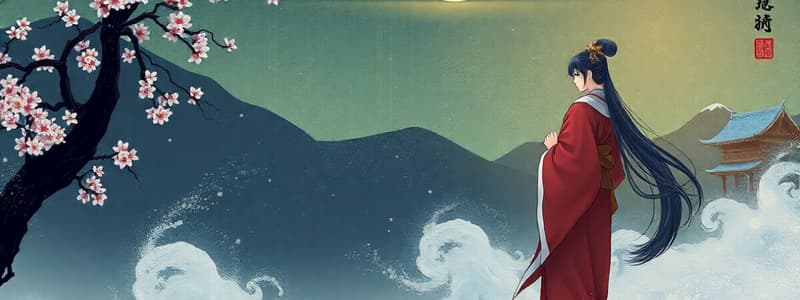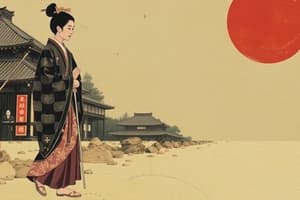Podcast
Questions and Answers
During the Heian period, what limited the broader population's engagement with literature?
During the Heian period, what limited the broader population's engagement with literature?
- Literacy was largely confined to the nobility and Buddhist clergy. (correct)
- The primary literary works were written in foreign languages.
- Literature's subject matter was deemed too complex for common understanding.
- There was a cultural bias against literary pursuits among the lower classes.
How did the monk Kukai's return from China influence Japanese culture during the Heian Period?
How did the monk Kukai's return from China influence Japanese culture during the Heian Period?
- He initiated agricultural reforms that led to increased wealth and cultural development.
- He introduced a new form of martial arts that became integrated into Japanese society.
- He established a new system of governance that prioritized artistic expression.
- He developed the Japanese alphabet and introduced new forms of Buddhism. (correct)
What was the primary impact of the rise of Buddhism on Japanese art during the Heian period?
What was the primary impact of the rise of Buddhism on Japanese art during the Heian period?
- It fostered a sense of isolationism, causing Japanese art to become more insular and less open to outside influences.
- It shifted the focus of most Japanese art towards Buddhist themes and opened Japan to foreign artistic influences. (correct)
- It created a divide between religious and secular art, with secular art becoming less valued.
- It led to a decline in artistic production due to the religion's focus on spiritual matters over material creation.
How did the introduction of mandalas influence Japanese architecture during the Heian period?
How did the introduction of mandalas influence Japanese architecture during the Heian period?
Why did new Buddhist temples in Japan retain strong local Japanese characteristics despite the influence of Chinese and Indian styles?
Why did new Buddhist temples in Japan retain strong local Japanese characteristics despite the influence of Chinese and Indian styles?
How did Kukai's development of kana significantly influence Japanese literature during the Heian Period?
How did Kukai's development of kana significantly influence Japanese literature during the Heian Period?
What distinguishes Monogatari as a unique form of literature that emerged during the Heian Period?
What distinguishes Monogatari as a unique form of literature that emerged during the Heian Period?
Why is Murasaki Shikibu's 'The Tale of Genji' considered a masterpiece of the Heian Period and a significant work in world history?
Why is Murasaki Shikibu's 'The Tale of Genji' considered a masterpiece of the Heian Period and a significant work in world history?
Besides Monogatari, what other forms of literature gained popularity during the Heian Period?
Besides Monogatari, what other forms of literature gained popularity during the Heian Period?
What lasting impact did Heian Period literature have on modern Japan, as evidenced by 'Kimigayo'?
What lasting impact did Heian Period literature have on modern Japan, as evidenced by 'Kimigayo'?
Flashcards
Heian Period
Heian Period
A period in Japanese history (794-1185) when the imperial court was located in Heian-kyo (now Kyoto), known for its art and literature.
Kana
Kana
Japanese alphabet of characters representing syllables, developed by the Buddhist priest Kukai.
Monogatari
Monogatari
A form of Japanese literature featuring lengthy fictional narratives, popular during the Heian Period.
The Tale of Genji
The Tale of Genji
Signup and view all the flashcards
Heian Poetry
Heian Poetry
Signup and view all the flashcards
Heian Literacy
Heian Literacy
Signup and view all the flashcards
Kukai's Impact
Kukai's Impact
Signup and view all the flashcards
Buddhism's Artistic Role
Buddhism's Artistic Role
Signup and view all the flashcards
Mandalas
Mandalas
Signup and view all the flashcards
Temple Architecture
Temple Architecture
Signup and view all the flashcards
Study Notes
- Much of what Japan considers to be its traditional culture comes from the Heian Period, lasting from 794-1185.
- The imperial court was moved to Heian-kyo (modern Kyoto) during this time.
- Artists and writers developed new styles of art and literature that influenced Japan for centuries.
Heian Literature and Drama
- Literature blossomed due to a major development in writing.
- In the early 9th century, the Buddhist priest Kukai traveled to China and determined the Japanese language was better represented by characters for sounds.
- Kukai developed kana, the Japanese alphabet of characters representing syllables.
- Literature entered a golden age, characterized by the development of Monogatari.
- Monogatari is a form of literature featuring a lengthy fictional narrative.
- Monogatari works are some of the first forms of writing comparable to the modern novel.
- Japanese authors composed dramatic works about imperial life, love, betrayal, and even science fiction.
- In the early 11th century, Murasaki Shikibu wrote The Tale of Genji, considered the first masterpiece in Japan.
- Diaries became very popular as a form of literature, and Japanese poetry also thrived.
- The Heian poem 'Kimigayo' is the nation's national anthem in modern Japan.
- Only nobles and Buddhist priests were literate.
Art in Heian Japan
- Buddhism grew to be hugely influential during the Heian Period, affecting art in two dramatic ways.
- The majority of Japanese art centered around Buddhism and Buddhist teachings.
- Japan became very open to foreign influences as Chinese and Indian forms of Buddhist art mixed with local styles.
- Mandalas, diagrams of the spiritual universe, influenced Japanese architecture.
- New Buddhist temples reflected Chinese and Indian styles, while retaining strong local Japanese characteristics.
- The new temples were built deep in the mountains where irregular topography and resources encouraged local architectural techniques.
Studying That Suits You
Use AI to generate personalized quizzes and flashcards to suit your learning preferences.
Description
Explore the blossoming of literature during Japan's Heian Period (794-1185). Discover the development of kana by Kukai, influencing art and literature for centuries. Learn about Monogatari, a form of early Japanese novel, and the dramatic works about imperial life.




